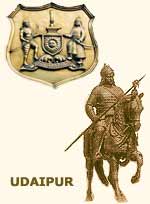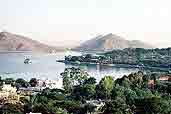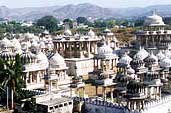 The Lake City – Udaipur is bathed in a mild, almost feminine aura,which contrast greatly with the harsher tone of Rajasthan’s numerous fortress towns. also known as city of Dawn, is a lovely land around the azure water lake,hemmed in by the lush hills of the Aravallis. A vision in white drenched in romance and beauty, Udaipur is a fascinating blend of sights, sound and experiences and inspiration for the imagination of poets, painters and writers.
The Lake City – Udaipur is bathed in a mild, almost feminine aura,which contrast greatly with the harsher tone of Rajasthan’s numerous fortress towns. also known as city of Dawn, is a lovely land around the azure water lake,hemmed in by the lush hills of the Aravallis. A vision in white drenched in romance and beauty, Udaipur is a fascinating blend of sights, sound and experiences and inspiration for the imagination of poets, painters and writers.
Udiapur is the jewel of Mewar-a kingdom ruled by the Sisodia dynasty for 1200 Years. The foundation of the city has an interesting legend associated with it. According to it, Maharana Udai Singh, the founder,was hunting one day when he met a holy man meditations on a hill overlooking the Lake Pichola.
The hermit blessed the Maharana and advised him to build a palace at this favorable located spot with a fertile valley watered by the stream, a lake,an agreeable altitude and an ampitheatre of low mountains. Maharana followed the advise of the hermit and founded the city in 1559 A.D.
PRIME SITES
 City Palace : A majestic architectural marvel towering over the lake on a hill surrounded by crenallated walls, it is a conglomeration of courtyards,pavilions,terraces,corridors,rooms and hanging gardens. The main entrance is through the triple arched gate, the ‘Tripolia’with eight marble porticos. The Maharana were weighed under the gate in the gold,the equivalent amount of which was distributed among the populace.
City Palace : A majestic architectural marvel towering over the lake on a hill surrounded by crenallated walls, it is a conglomeration of courtyards,pavilions,terraces,corridors,rooms and hanging gardens. The main entrance is through the triple arched gate, the ‘Tripolia’with eight marble porticos. The Maharana were weighed under the gate in the gold,the equivalent amount of which was distributed among the populace.
The Suraj Gokhada, the balcony of the sun, is where the Suryavanshi Maharanas of Mewar presented themselves to the people in time of trouble to restore their confidence. The ‘Mor Chowk’ known for its exquisite peacock mosaics in glass and the ‘Chini Chitrashala’noted for its blue and white ceramics are other attractions in the palace.
Jagdish Temple : Built in 1651 A.D. By Maharana Jagat Singh, this Indo-Aryan temple is the largest and the most beautiful temple of Udaipur with noteworthy sculpted images.
 Saheliyon-ki-Bari : This small ornamental garden was a popular relaxing spot where royal ladies came for a stroll and hence the name. The garden has many natural fountains in its four delightful pools,chiseled kiosks and marble elephants.
Saheliyon-ki-Bari : This small ornamental garden was a popular relaxing spot where royal ladies came for a stroll and hence the name. The garden has many natural fountains in its four delightful pools,chiseled kiosks and marble elephants.
Bharatiya Lok Kala Museum : The interesting collection exhibited by this Indian folk arts museum includes folk dresses,ornaments,puppets,masks,dolls,folk musical instruments, folk deities and paintings.
 Fateh Sagar Lake : A beautiful lake,overlooked by a number of Aravali hills on the three sides and the Pratap Memorial on the north was built by Maharana Fateh Singh. In the middle of the lake is Nehru Park-a lovely garden island with a boat shaped café accessible by an enjoyable boat ride.
Fateh Sagar Lake : A beautiful lake,overlooked by a number of Aravali hills on the three sides and the Pratap Memorial on the north was built by Maharana Fateh Singh. In the middle of the lake is Nehru Park-a lovely garden island with a boat shaped café accessible by an enjoyable boat ride.
Pichola Lake : The picturesque lake that entranced Maharaja Udai Singh. It was later enlarged by the founder. The lake is surrounded by hills,palaces,temples,bathing ghats and embankments. Two island palaces, Jag Mandir and Lake Palace on the lake are of breathtaking magnificence.

Pratap Memorial : Moti Magri also known as pearl hill, overlooking the Fateh Sagar Lake is the memorial of the Great Rajput hero Maharana Pratap with a bronze statue of the Maharana.
 Ahar Museum : The ancient capital of Sisodias, 3 km from Udaipur,Ahar boasts of a profusion of royal cenotaphs of the rulers of Mewar. A rare collection of antiquities including earthen pots, iron objects and other art items excavated in the region are displayed in a small Govt. museum.
Ahar Museum : The ancient capital of Sisodias, 3 km from Udaipur,Ahar boasts of a profusion of royal cenotaphs of the rulers of Mewar. A rare collection of antiquities including earthen pots, iron objects and other art items excavated in the region are displayed in a small Govt. museum.
Sajjan Garh : Also known as Mansoon Palace Dominating the city’s skyline.It offers a panoramic overview of the city’s lakes,palaces and the surrounding countryside.
Gulab Bagh : A spectacular rose garden laid out by Maharana Sajjan Singh. A library in the Navlakha Mahal has a rare collection of ancient handwritten manuscripts and books
 SHILPGRAM : West Zone Cultural Centre of India has set up an artisan’s crafts village at 3 Kms west of Udaipur. It is a living ethnographic museum depecting life style, traditions, customs and folk arts of the rural and tribal people of the states of Rajasthan, Maharashtra, Gujrat, Goa, Daman, etc. There are several huts constructed in the traditional architectural style using mud and local building material to reflect the geographical and ethnic diversity of the different states of west zone of India. The rural artisans and folk artists reside here and perform in the natural surroundings in a village environment. Every year, more than a lakh visitors visit this village which is spread out in an area of 55 acres, surrounded by Aravali mountains. The Shilpgram Utsav organised every year from 23rd December to January 1st, attracts massive crowd creating a scene of rural market fair and festival with live performance of folk artist from different parts of the country. The Terracotta Museum, the museum of masks, folk and musical instruments are of particular attraction
SHILPGRAM : West Zone Cultural Centre of India has set up an artisan’s crafts village at 3 Kms west of Udaipur. It is a living ethnographic museum depecting life style, traditions, customs and folk arts of the rural and tribal people of the states of Rajasthan, Maharashtra, Gujrat, Goa, Daman, etc. There are several huts constructed in the traditional architectural style using mud and local building material to reflect the geographical and ethnic diversity of the different states of west zone of India. The rural artisans and folk artists reside here and perform in the natural surroundings in a village environment. Every year, more than a lakh visitors visit this village which is spread out in an area of 55 acres, surrounded by Aravali mountains. The Shilpgram Utsav organised every year from 23rd December to January 1st, attracts massive crowd creating a scene of rural market fair and festival with live performance of folk artist from different parts of the country. The Terracotta Museum, the museum of masks, folk and musical instruments are of particular attraction
 Bagor Ki Haveli : Situated on the bank of Pichola Lake, This Haveli was built by Shri Amarchand Badwa, who was the Prime Minister of Mewar-the rulers of Mewar Pratap Singh, Maharana Ari Singh, Maharana Hamir Singh during the period 1751 to 1778. This palatial building reportedly has 138 rooms, balconies, terraces, courtyards and corridors. The glass and mirror inlay within the Haveli is Unique and procured in its original form. The two peacocks made with small pieces of colored glasses are unique reflection of the finest craftsmanship of glass work. What was once upon a time a living centre of nobility of Udaipur lay in darkness and ruin for nearly half a century till when it was handed over to the West Zone Cultural Centre (WZCC) in 1986.
Bagor Ki Haveli : Situated on the bank of Pichola Lake, This Haveli was built by Shri Amarchand Badwa, who was the Prime Minister of Mewar-the rulers of Mewar Pratap Singh, Maharana Ari Singh, Maharana Hamir Singh during the period 1751 to 1778. This palatial building reportedly has 138 rooms, balconies, terraces, courtyards and corridors. The glass and mirror inlay within the Haveli is Unique and procured in its original form. The two peacocks made with small pieces of colored glasses are unique reflection of the finest craftsmanship of glass work. What was once upon a time a living centre of nobility of Udaipur lay in darkness and ruin for nearly half a century till when it was handed over to the West Zone Cultural Centre (WZCC) in 1986.
EXCURSIONS
 Eklingji (22 km): Built in 734 A.D. is the beautifully sculpted temple complex with 108 temples within its high walls. The temples are dedicated to Lord Shiva, the presiding deity of Mewar rulers. The walled complex encloses and elaborately pillared hall or ‘mandap’ under a large pyramidal roof and has four-faced image of Lord Shiva in black marble.
Eklingji (22 km): Built in 734 A.D. is the beautifully sculpted temple complex with 108 temples within its high walls. The temples are dedicated to Lord Shiva, the presiding deity of Mewar rulers. The walled complex encloses and elaborately pillared hall or ‘mandap’ under a large pyramidal roof and has four-faced image of Lord Shiva in black marble.
Nagda (23 km): The ancient site dating back to the 6th century A.D. is renowned for the Sas-Bahu temples (9t – 10th century A.D.) with interesting architecture and carvings. The splendid Jain temples of Adbudji are also worth a visit.
Haldighati (44 km): A historical site, witness to the great battle fought between Maharana Pratap and Mughal Emperor Akbar in 1576 A.D. The Chhatri of Maharana’s horse-Chetak is noteworthy.
 Nathdwara (50 km): The most reverred 17th century shrine, dedicated Shrinathji or Lord Krishna, attracts thousands of Pilgrims from all over the country,especially during Diwali, Holi and Janmashtami festivals.
Nathdwara (50 km): The most reverred 17th century shrine, dedicated Shrinathji or Lord Krishna, attracts thousands of Pilgrims from all over the country,especially during Diwali, Holi and Janmashtami festivals.
Kankroli (65 km): An important vaishnava temple popularly called Dwarikadish. It is the most important temple of the Vallabhacharya sect,built to resemble the famous Nathdwara shrine.
Rajsamand Lake (66 km): Close to Kankroli is the dam built by Maharana Raj Singh in 1660 A.D. Many ornamental arches and chhatris adorn the embankment.
 Fort Kumbhalgarh (84 km) : This is the most important fort in the Mewar region after Chittorgarh. It’s an isolated and fascinating place 84 km from Udaipur, builtby Maharana Kumbha in the 15th century.Because of its inaccessibility at 1100m on top of the Aravalli Range it was taken only once in its history.There’s also a large sanctuary here, known for its wolves. The scarcity of water holes between March and June makes this the besttime to see animals.Leopard, panther and sloth bear. This is one of the few sanctuaries that allows people to enter on ‘horseback’.
Fort Kumbhalgarh (84 km) : This is the most important fort in the Mewar region after Chittorgarh. It’s an isolated and fascinating place 84 km from Udaipur, builtby Maharana Kumbha in the 15th century.Because of its inaccessibility at 1100m on top of the Aravalli Range it was taken only once in its history.There’s also a large sanctuary here, known for its wolves. The scarcity of water holes between March and June makes this the besttime to see animals.Leopard, panther and sloth bear. This is one of the few sanctuaries that allows people to enter on ‘horseback’.
 Ranakpur (90 km): The beautifully sculptured Jain temples lie in a tranquil valley of the Aravallis. The main ‘Chaumukha Temple’ is dedicated to the tirthankara Adinath and has 29 halls supported by 1444 pillars, all distinctly carved. Two jain temples dedicated to Neminath and Parsvanath and a Sun Temple a little distance away ,are also noteworthy.
Ranakpur (90 km): The beautifully sculptured Jain temples lie in a tranquil valley of the Aravallis. The main ‘Chaumukha Temple’ is dedicated to the tirthankara Adinath and has 29 halls supported by 1444 pillars, all distinctly carved. Two jain temples dedicated to Neminath and Parsvanath and a Sun Temple a little distance away ,are also noteworthy.
Jagat (58 km): The splendid and well preserved 10th century temple of Ambika Mata is known for its intricate carvings in the outer walls. Popularly known as the Khajuraho of Rajasthan.
 Jaisamand Lake (48 km): A stunningly situated artificial lake, built in the 17th century A.D. by Maharana Jai Singh is the second largest in Asia. Graceful marble chhatris flank the embankment and beautiful summer palaces of the Udaipur queens are built on either side of the lake. Jaisamand Island Resort is also worth visiting.
Jaisamand Lake (48 km): A stunningly situated artificial lake, built in the 17th century A.D. by Maharana Jai Singh is the second largest in Asia. Graceful marble chhatris flank the embankment and beautiful summer palaces of the Udaipur queens are built on either side of the lake. Jaisamand Island Resort is also worth visiting.
A trip to Jaisamand Wildlife Sanctuary allows a close encounter with the rich wildlife in their natural habitat. The fauna includes panther,wild boar,deer,four honed antelope, mongoose and various species of migratory birds.
Chittor Garh ( 110 km ) : The hilltop fortress of Chittorgarh epitomizes the whole romantic, doomed ideal of Rajput chivalry. Three times in its long history, Chittor was sacked by a stronger enemy and, on each occasion, the end carne in textbook Rajput fashion as jauhar was declared in the face of impossible odds. The men donned the saffron robes of martyrdom and rode out from the fort to certain death, while the women and children immolated themselves on a huge funeral pyre. Honour was always more important than death.
